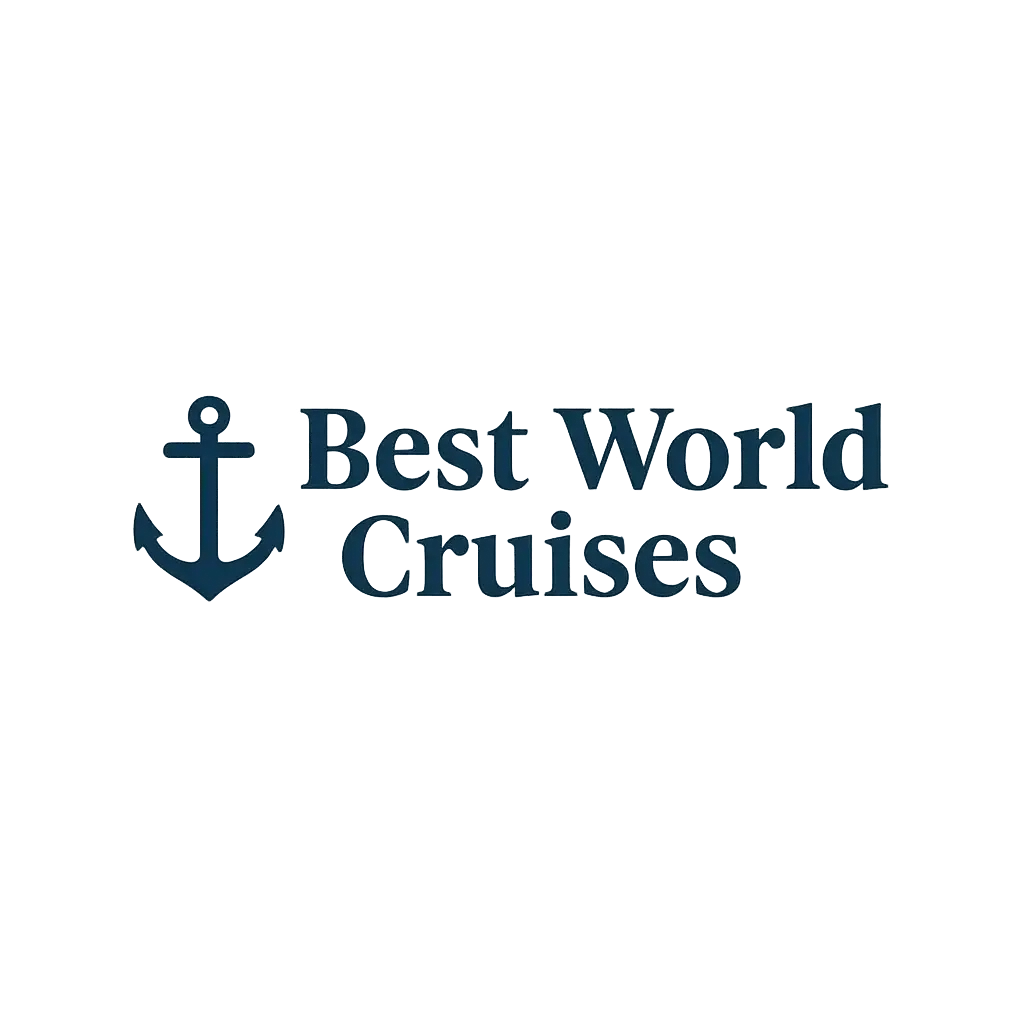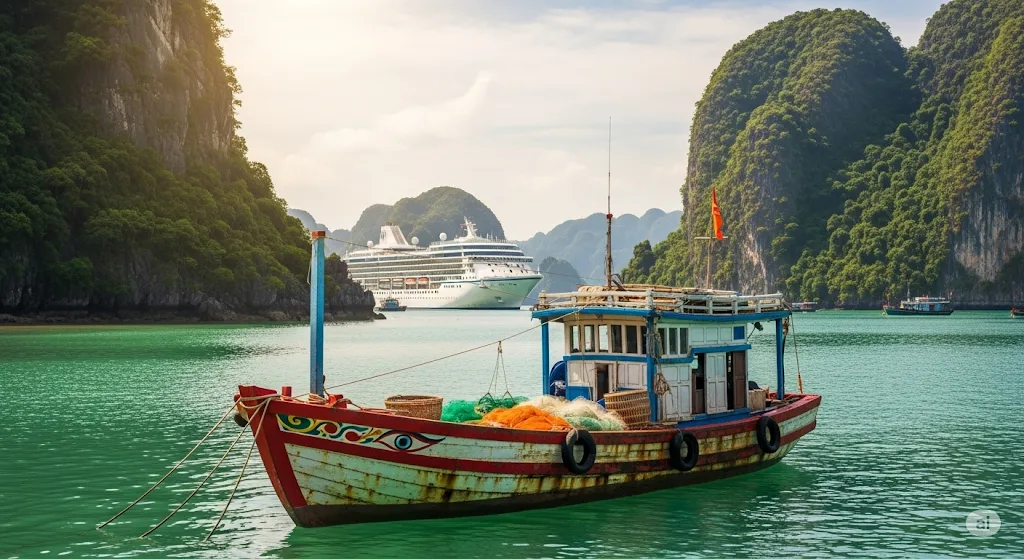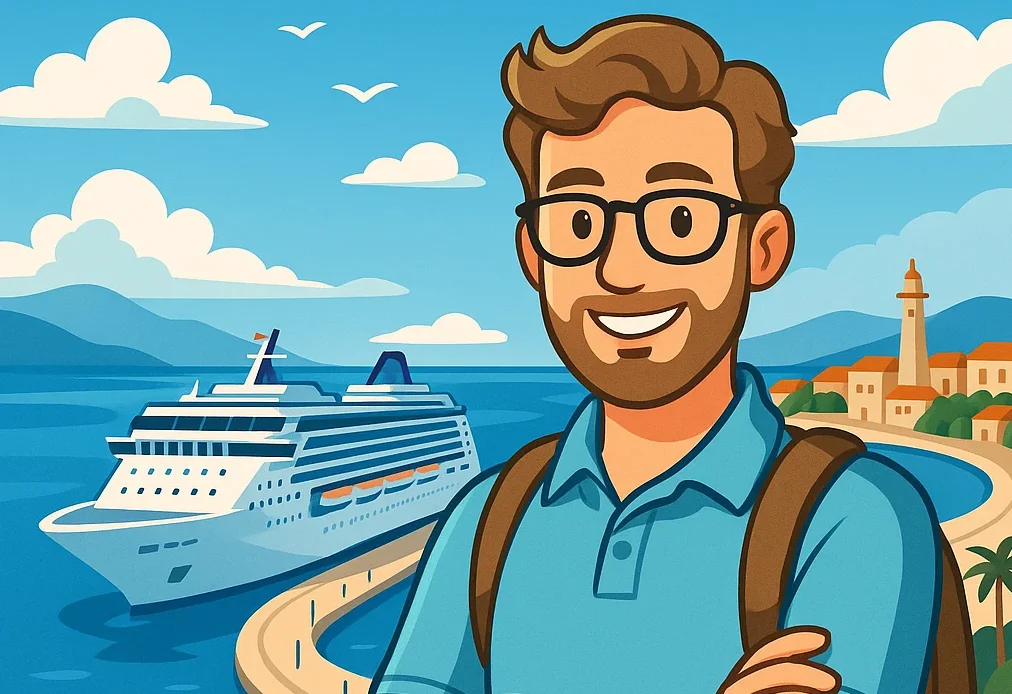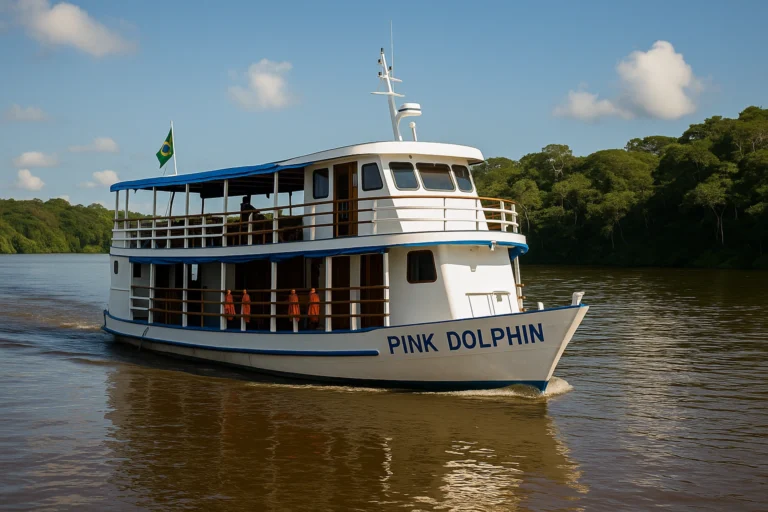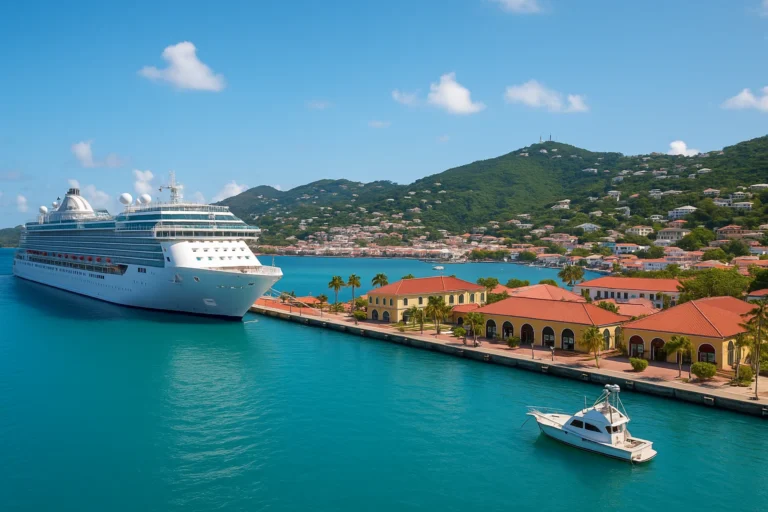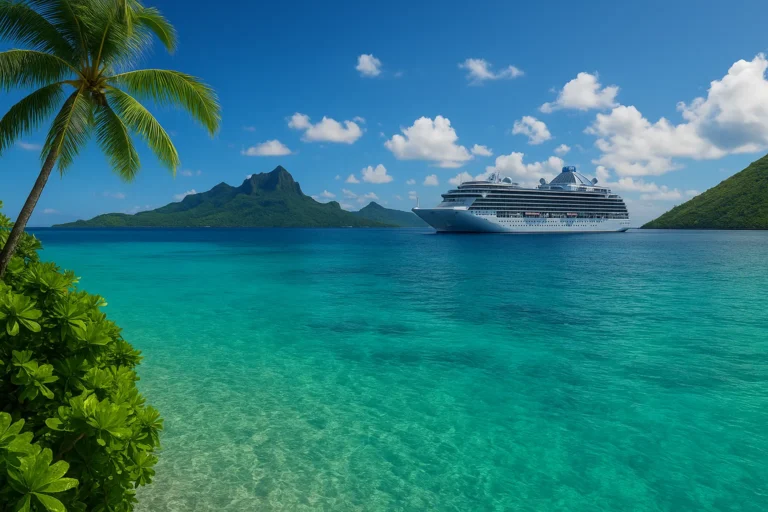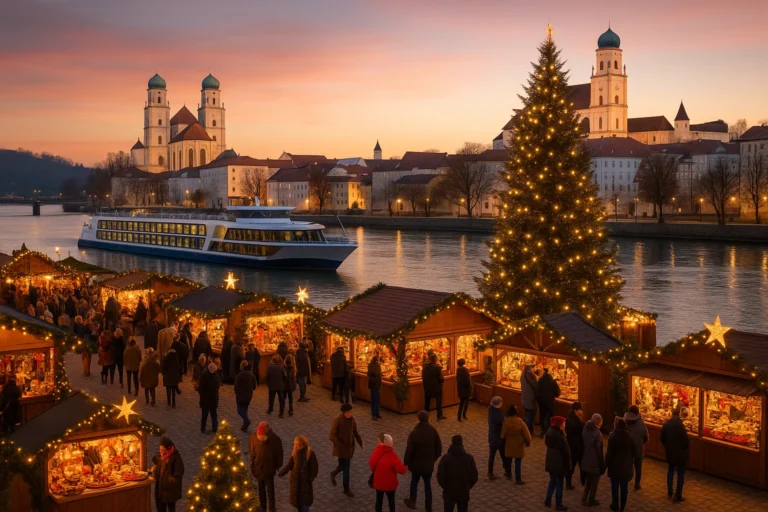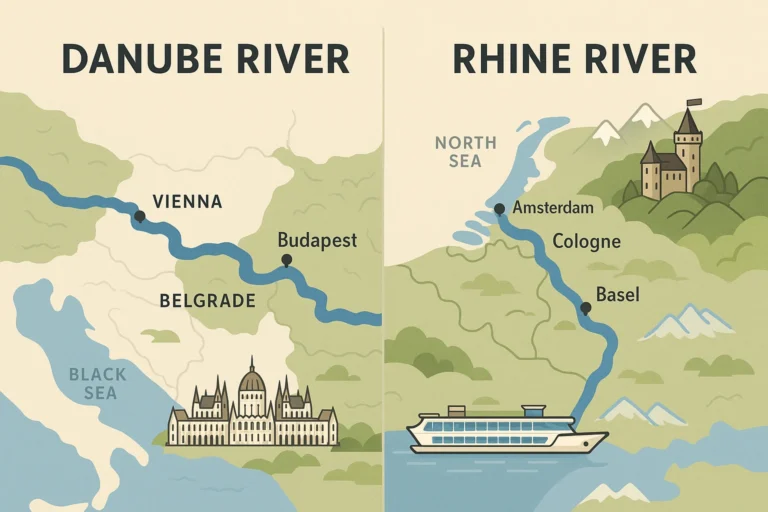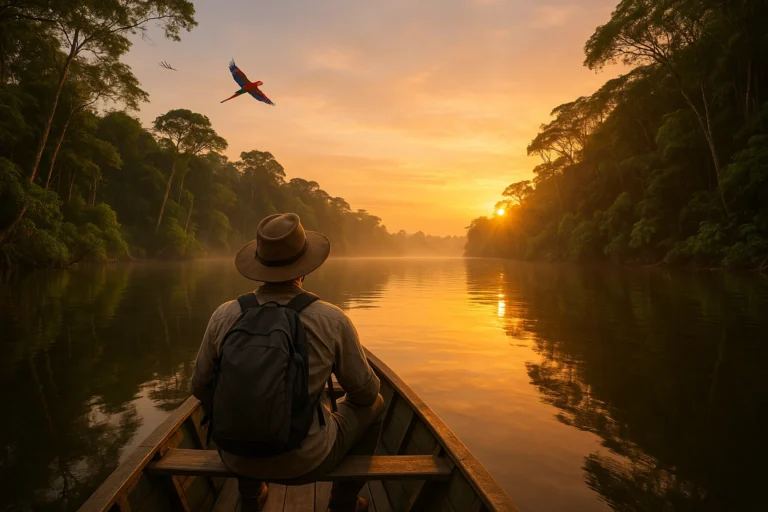Asia’s Hidden Cruise Ports: Exploring Less-Known Gems in Vietnam and Thailand
Asia’s Hidden Cruise Ports: Exploring Less-Known Gems in Vietnam and Thailand, In the world of modern cruising, the focus is often on the major, well-established ports of call. These bustling hubs, from Singapore’s futuristic skyline to Hong Kong’s iconic harbor, offer undeniable appeal. Yet, for the seasoned traveler seeking a deeper, more authentic experience, the true magic of a Southeast Asian cruise lies in its hidden gems. Tucked away from the mega-ships and bustling crowds are smaller, less-known ports in Vietnam and Thailand that serve as gateways to a different kind of adventure. This is an invitation to explore a more genuine side of Asia—one defined by untouched landscapes, vibrant local cultures, and the kind of tranquility that only exists away from the tourist masses. By venturing into these lesser-known destinations, you embark on a journey of discovery, transforming a standard vacation into a truly memorable expedition.
Chapter I: Why Choose Less-Known Ports?
The allure of an off-the-beaten-path cruise extends far beyond simply avoiding crowds. It’s about a fundamental shift in travel philosophy—from a checklist of famous sights to a genuine immersion in the local way of life. When you dock at a smaller port, you step into a world that feels more intimate and personal. The pace is slower, the experiences are more tailored, and the connection with the destination is more profound.
Authentic Experiences and Local Connection
In major cruise ports, shore excursions are often large-scale, pre-packaged tours that cater to hundreds of people at once. While efficient, they can lack a personal touch. In a hidden gem port, the dynamic changes entirely. You’re more likely to find small-group tours led by local guides who share personal stories and insights. This might mean joining a cooking class in a family home, visiting a small-scale artisanal workshop, or taking a local longtail boat tour through a tranquil mangrove forest. These interactions are not just transactions; they are cultural exchanges that foster a deeper appreciation for the place you are visiting. Instead of a quick photo opportunity, you might find yourself sharing a meal with a local family or learning about their daily lives, creating memories that are far more meaningful than any souvenir. The absence of mass tourism infrastructure means that the local economy directly benefits from your visit, as your money goes to small businesses and individual guides, creating a more sustainable and equitable form of travel. Furthermore, the less commercialized environment allows you to witness daily life as it truly is, from fishermen mending their nets to children playing in the streets, providing a raw and unfiltered glimpse into a different culture.
Untouched Landscapes and Tranquility
Many of the world’s most beautiful destinations have been transformed by tourism, their natural beauty sometimes overshadowed by large resorts, souvenir shops, and constant noise. The hidden ports of Vietnam and Thailand, however, offer a refuge from this. These are places where pristine beaches, ancient temples, and lush national parks are preserved in their natural state. The lack of large crowds means you can experience these wonders in peace, truly absorbing the tranquility of your surroundings. Imagine watching the sunrise over a serene bay with only the sound of the waves, or exploring a centuries-old temple without the distraction of dozens of other tourists. This is the kind of peace and quiet that is becoming increasingly rare in our over-connected world. It’s an opportunity for a digital detox and a reconnection with nature. The ecosystems around these ports are often healthier and more vibrant, providing a better chance to see local wildlife and marine life in their natural habitats. The air feels cleaner, the water looks clearer, and the overall atmosphere invites a sense of calm and rejuvenation that is impossible to find in a bustling metropolis. The journey itself, often through scenic waterways or past stunning coastal scenery, becomes part of the adventure, rather than just a means to an end.
Chapter II: The Hidden Gems of Vietnam
Vietnam, a country of breathtaking landscapes, rich history, and vibrant culture, offers an abundance of lesser-known ports that provide a gateway to its most authentic experiences. Moving beyond the well-trodden paths of Ho Chi Minh City, these destinations reveal a different side of the nation’s charm and resilience.
Vung Tau: A Gateway to Southern Vietnam’s Spirit
While often serving as a deepwater port for Ho Chi Minh City, Vung Tau itself is a fascinating destination worthy of a full day’s exploration. This former French colonial town, known as Cap Saint-Jacques, retains a relaxed seaside charm that is a refreshing contrast to the capital’s chaotic energy. The port provides a strategic entry point to explore the bustling life of Southern Vietnam, including the vibrant markets and historical sites of Ho Chi Minh City itself. However, instead of rushing to the city, consider staying and exploring Vung Tau’s unique attractions. You can ascend the small mountain to visit the giant Jesus Christ Statue, a replica of the one in Rio de Janeiro, offering breathtaking panoramic views of the city and the coast. The historic Vung Tau Lighthouse, perched atop another hill, provides equally stunning vistas. The city’s beaches, like Front Beach (Bai Truoc) and Back Beach (Bai Sau), are popular with local tourists and offer a glimpse into everyday life. The seafood here is exceptionally fresh and cheap, a testament to the city’s fishing industry. Walking through the local markets, you’ll find a wide variety of fresh produce, spices, and handcrafted goods, offering an authentic shopping experience far removed from the sterile environment of a tourist souvenir shop. This port is perfect for travelers who appreciate history, scenic views, and the opportunity to feel the pulse of a local coastal community. The relaxed atmosphere and genuine hospitality of the locals make for a truly memorable stop. You can also explore the remnants of French colonial architecture, which adds a layer of historical intrigue to the city’s modern character.
Da Nang: A Perfect Blend of Ancient and Modern
Da Nang, a city rapidly rising on the global tourism map, is a cruise port that seamlessly blends historical heritage with cutting-edge modernity. Located in Central Vietnam, it is the ideal base for exploring a region rich in cultural and natural wonders. Its most famous nearby attraction is the ancient town of Hoi An, a UNESCO World Heritage Site located just a short drive away. With its beautifully preserved Japanese merchant houses, Chinese temples, and colorful lanterns, Hoi An feels like a step back in time. Visitors can wander through its car-free streets, shop for bespoke clothing and leather goods, or enjoy a meal at one of the riverside restaurants. Back in Da Nang, the Marble Mountains are a must-see. This cluster of five limestone and marble hills is home to a network of caves, tunnels, and Buddhist sanctuaries, offering a unique blend of natural beauty and spiritual significance. The views from the top are spectacular. The city’s own beaches, including the famous My Khe Beach (China Beach), are perfect for sunbathing and water sports. The Dragon Bridge, which breathes fire and water on weekend nights, is an iconic modern landmark that symbolizes Da Nang’s forward-looking spirit. The city also has a burgeoning culinary scene, from street food stalls serving delicious local specialties to upscale dining establishments. Da Nang provides an incredibly well-rounded cruise experience, offering a perfect balance of cultural exploration, natural beauty, and modern convenience. Unlike more rustic ports, its well-developed infrastructure makes independent exploration easy and enjoyable. The city’s strategic location also allows for easy access to other sites of historical importance, such as the ancient Cham ruins at My Son, which provides another layer of historical context to the region.
Halong Bay: The Legendary Landscape
Although not a “hidden” port, a cruise stop at Halong Bay is an essential and iconic part of any comprehensive Vietnam itinerary. The bay is a UNESCO World Heritage Site renowned for its dramatic landscape of thousands of limestone karsts and isles of various shapes and sizes. While many large cruise ships anchor here, the true experience lies in the smaller, local boats that navigate the labyrinthine waterways. A shore excursion from your cruise ship typically involves a day trip on a smaller vessel to explore the inner parts of the bay. You can visit the Thien Cung Cave, also known as the “Heavenly Palace Cave,” with its stunning stalactites and stalagmites, or the Dau Go Cave, with its vast and intricate formations. Kayaking is a popular activity, allowing you to paddle right up to the base of the karsts and into hidden coves. The tranquility of the bay is a stark contrast to the busy port, and the sheer scale of the landscape is awe-inspiring. For a more authentic experience, some tours include a visit to a local floating fishing village, where you can see how families live and work on the water. While Halong Bay’s popularity means you won’t be alone, the sheer size of the bay ensures that it never feels truly crowded, and its ethereal beauty is a powerful reminder of Vietnam’s natural wonders. The misty mornings and golden sunsets over the bay create a mystical atmosphere that makes it a photographer’s dream. The geological formations tell a story of millions of years of natural processes, providing a deeper appreciation for the unique ecosystem.
Chapter III: The Hidden Treasures of Thailand
Thailand’s islands and coastal towns are famous for a reason, but venturing beyond the well-trodden routes of Phuket and Bangkok reveals an even more captivating side of the “Land of Smiles.” These destinations offer a blend of stunning natural beauty, spiritual tranquility, and authentic local culture.
Koh Samui: More Than a Beach Island
While Koh Samui is a well-known tourist destination, its cruise port in Nathon offers a gateway to a more authentic island experience than its larger counterparts. Nathon is the island’s administrative and commercial hub, and it maintains a more local feel. From here, you can escape the tourist hotspots and explore the island’s lush, mountainous interior. The Na Muang Waterfalls, for instance, offer a refreshing break and a chance to trek through the jungle. The island is also home to some beautiful and unique temples, such as the impressive Wat Phra Yai, home to the Big Buddha statue, and the colorful Wat Plai Laem, with its intricate statues of Chinese and Thai deities. For an authentic cultural experience, consider a visit to the Fisherman’s Village in Bophut, a charming, well-preserved village with wooden shophouses, boutique shops, and excellent restaurants. Unlike the more commercialized areas, this village offers a glimpse into the island’s traditional way of life. For nature lovers, a tour to Ang Thong Marine National Park, a protected archipelago of 42 islands, is a must. Here you can kayak through sea caves, snorkel in crystal-clear waters, and hike to viewpoints with breathtaking scenery. Ang Thong is an example of the kind of untouched natural beauty that is a hallmark of a less-commercialized cruise port. The island’s culinary scene is also a highlight, with fresh seafood and authentic Thai dishes available at local restaurants. From bustling markets to serene coconut groves, Koh Samui offers a microcosm of Thailand’s diverse offerings.
Krabi: Dramatic Landscapes and Local Culture
With its towering limestone cliffs jutting out of the emerald-green water, Krabi province is a visual masterpiece and a fantastic cruise destination. The port of Krabi Town is an ideal starting point for a variety of unforgettable adventures. The world-famous Railay Beach and Phra Nang Cave Beach are accessible only by longtail boat and are famous for their dramatic scenery, rock climbing opportunities, and pristine white sand. The nearby Phi Phi Islands (Ko Phi Phi Don and Ko Phi Phi Leh, home to the famous Maya Bay) are also a popular day trip, offering snorkeling, diving, and stunning coastal views. For a more authentic experience, you can explore the quieter side of the province. Take a traditional longtail boat tour through the mangrove forests, a vital ecosystem that supports a wide variety of wildlife. You can also visit the local markets in Krabi Town, where you’ll find fresh produce, street food, and handcrafted goods, offering a genuine glimpse into daily life. The town itself has a laid-back vibe and a beautiful riverside promenade. The Tiger Cave Temple (Wat Tham Suea), a sacred Buddhist site, offers a challenging climb of over 1,200 steps to the summit, but rewards visitors with a stunning view of the surrounding landscape and a giant golden Buddha statue. Krabi provides a perfect blend of adventure and relaxation, appealing to both adrenaline junkies and those seeking natural tranquility. The stunning backdrop of the cliffs and islands makes it a top destination for photographers and nature lovers alike. The area is also a major center for ecotourism, with many local operators focusing on sustainable practices that protect the delicate marine environment.
Laem Chabang: The Gateway to Authentic Central Thailand
Often overlooked as a simple industrial port for Bangkok, Laem Chabang is in fact a strategic and surprisingly versatile gateway to a different side of Central Thailand. Instead of braving the long journey to the chaotic heart of Bangkok, which is often a multi-hour bus ride from the port, visitors can explore the more manageable and culturally rich areas nearby. A short drive will take you to Pattaya, which has a reputation for its nightlife, but also offers beautiful temples, floating markets, and a more accessible, laid-back coastal vibe. More importantly, Laem Chabang is a perfect starting point for discovering some of Thailand’s historical and spiritual treasures. You can visit the Sanctuary of Truth, a massive all-wood temple filled with intricate carvings, showcasing a fascinating blend of art and philosophy. The Nong Nooch Tropical Garden is another popular attraction, with beautifully manicured gardens, elephant shows, and cultural performances. For a more traditional experience, consider visiting the nearby Sriracha Tiger Zoo (note: while popular, many travelers prefer to avoid animal-based attractions due to ethical concerns). The real value of Laem Chabang lies in its proximity to the rural, authentic heart of Thailand. You can hire a private car or local guide to take you to smaller villages, pineapple plantations, or local markets where you can sample fresh fruit and local delicacies. This port offers a unique opportunity to explore a side of Thailand that cruise passengers rarely get to see, providing a much-needed break from the typical tourist crowds. It’s a port for the traveler who wants to create their own unique itinerary and discover the true soul of the country beyond its most famous landmarks.
📂 Explore More in These Categories
Asia Cruises 2025: Best Itineraries, Ports & Deals
Best Cruise Destinations in 2025: Caribbean, Europe & Bucket List Ports
Chapter IV: Practical Tips for Brave Explorers
Embarking on a cruise to hidden ports requires a different mindset and a little more preparation. Here are some essential tips to ensure your adventure is both seamless and unforgettable.
Navigating Local Logistics
In less-developed ports, getting around might not be as straightforward as hailing a taxi from a well-marked stand. Research local transportation options in advance. Tuktuks, local buses, or motorbike taxis are often the most common forms of transport. Always agree on a price before you start your journey. For peace of mind, consider booking a private tour or a taxi for the day through a reputable local company, which you can often find reviews for online. Ensure you have a map, either a physical one or a downloaded offline map on your phone, as cell service might be spotty. When exploring, keep track of time and give yourself a comfortable buffer to return to the ship before it departs. A common mistake is to underestimate travel times in unfamiliar areas. If you are a seasoned traveler, you might enjoy the spontaneity of exploring on your own, but for your first time, a pre-arranged tour can offer a stress-free introduction to the area. Many locals in tourist areas have a basic understanding of English, but having a phrasebook or translation app can be a great help. Don’t be afraid to ask for directions—locals are often friendly and willing to assist, and it’s a great way to have an authentic interaction.
Respecting Local Culture and the Environment
Travel to lesser-known areas carries a greater responsibility. Show respect for local traditions and customs. In both Vietnam and Thailand, modest dress is essential when visiting temples and religious sites. This means covering your shoulders and knees. It’s also respectful to remove your shoes before entering someone’s home or a temple. When interacting with locals, a simple “hello” in their language goes a long way. In Vietnam, it’s “Xin chào” (sin chow), and in Thailand, it’s “Sawasdee” (sa-wah-dee) for men and “Sawasdee ka” for women. Avoid engaging in overly loud or boisterous behavior, and always ask for permission before taking a photo of a person. From an environmental standpoint, be a mindful traveler. Avoid single-use plastics, choose tour operators who prioritize sustainability, and do not buy souvenirs made from protected or endangered animals or plants. By supporting local, small-scale businesses, you contribute directly to the community rather than large, international corporations. This form of tourism ensures that your visit has a positive and lasting impact on the destination. Understanding the concept of “mai pen rai” in Thailand, which means “no worries,” can help you embrace a more relaxed and flexible attitude towards unforeseen circumstances. This cultural understanding is key to a smooth and enjoyable trip.
Health and Safety Precautions
While generally safe, it’s important to take basic health and safety precautions when exploring these hidden ports. The tropical climate means it’s essential to stay hydrated and protect yourself from the sun. Always use a high-SPF sunscreen and wear a hat. Insect repellent is a must, particularly for excursions into more rural or jungle areas, to protect against mosquito-borne illnesses. When it comes to food and drink, be cautious with street food, especially if you have a sensitive stomach. While the food is incredibly delicious and a key part of the experience, it’s best to choose vendors who have a high turnover of customers, as this generally indicates fresh ingredients. Opt for bottled water and avoid ice in drinks unless you are certain it is made from purified water. It is a good idea to have some basic over-the-counter medications with you, such as motion sickness pills, antidiarrheals, and pain relievers, in case you need them. While your cruise ship’s medical center will be available for emergencies, having these small items on hand can save you a lot of time and hassle. Be aware of your surroundings, keep your valuables secure, and trust your instincts. Most importantly, inform your cruise ship of your plans and estimated time of return, especially if you are traveling independently, to ensure your safety and a smooth return to the vessel.
Frequently Asked Questions
Common questions about cruising to Asia’s hidden ports
💬 An Adventure Worth Exploring
Choosing a cruise that includes Asia’s hidden ports is a testament to a desire for authentic, meaningful travel. It’s a chance to step away from the predictable and embrace the unexpected. These destinations offer a unique blend of natural beauty, cultural depth, and genuine human connection that is increasingly rare in today’s fast-paced world. By preparing with an open mind and a sense of adventure, you will be rewarded with an experience that goes far beyond the typical vacation. The serene landscapes, the rich histories, and the warm smiles of the local people will leave an indelible mark on your memory, proving that sometimes, the most rewarding journeys are to the places you never knew you were looking for.
Are you ready to explore the hidden side of Asia? These gems are waiting for you.

